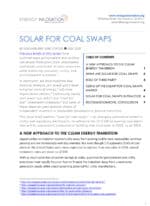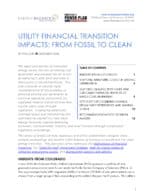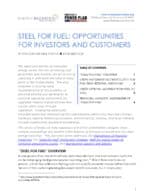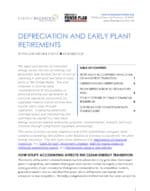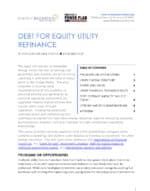Fossil fuel power plants are quickly becoming uneconomical compared to cheaper clean energy generation. More than 15 gigawatts (GW) of U.S. coal-fired power capacity is expected to close in 2018, and at least 36 GW of coal-fired capacity is forecast to be retired by 2024.
Regulators, utilities, and investors must work together to ensure customers benefit from closures while helping affected communities transition away from a coal-based economy.
This series of policy briefs highlights different tools to help utilities balance stakeholder interests, facilitate the financial transition away from uneconomic fossil fuel, and help states embrace clean energy.
Solar for Coal Swaps
Policymakers and utility executives must rapidly focus on how to finance the transition away from uneconomic generation assets while creating earning potential for utility shareholders. This issue brief explores an emerging model for refinancing the 22.5 GW of existing coal plants that will be uneconomic compared to building new local solar in 2025, as of 2018.
Utility Monospony Regulation: What’s Behind Low-Cost Wind and Solar Bids in Colorado?
Utilities can be regulated to address their monopsony market power so that competitive solicitations result in many bidders and low prices for generation projects, creating benefits for consumers and utility shareholders. This brief highlights lessons from Colorado’s experience leveling the playing field to ensure competitive bid results in the state are achievable as part of the financial transition away from uneconomic coal generation.
Utility Financial Transition Impact: From Fossil to Clean
By analyzing publicly available financial information, policymakers and utility stakeholders can identify where running existing fossil fuel generation costs more than replacing it with new wind or solar. A suite of financial instruments can facilitate and reduce costs of this financial transition away from fossil fuels toward clean energy.
This brief uses Colorado’s experience transitioning from coal to clean energy as a case study analyzing existing generation costs, and introduces financial tools to help electric utilities that own fossil generation manage the clean energy transition.
“Steel for Fuel”: Opportunities for Investors and Customers
Early retirement of uneconomic coal assets can improve shareholder earnings if a utility is allowed to reinvest capital in new renewable energy generation. When building new renewables is cheaper than operating existing coal, swapping steel for fuel adds value for investors, customers, and the environment.
This brief addresses equity shareholder perspectives and suggests how potential funding sources can mitigate impacts on communities and workers affected by early plant retirements while improving environmental performance.
Depreciation and Early Plant Retirements
Depreciation accounting recognizes asset value reduction over time. For coal plants, depreciation determines the value remaining when plants retire early. Depreciation is an important tool for transitioning away from older assets, such as coal plants, to cheaper resources, such as wind and solar.
This brief reviews how depreciation schedules affect utility earnings and ratepayer costs, as well as other stakeholder interests.
Debt for Equity Utility Refinance
When electric utilities transition from fossil fuels to clean energy, they must address unrecovered investment balances. Depreciation schedules are often accelerated to line up with earlier-than-planned retirement dates, which can increase short term consumer rates.
This brief reviews how utilities can refinance undepreciated balances on plants in service to lessen the consumer rate burden, primarily through replacing some portion of equity with corporate debt.

